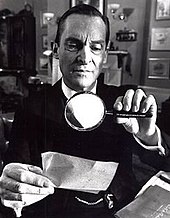The distinguished profile, the pipe, the deer-stalker's hat--this can be none other than Sherlock Holmes.
I love a mystery. As a teen, or young adult I spent Sunday mornings watching Sherlock Holmes played by the well known actor Basil Rathbone, who to me was a great actor and seemed to bring Holmes to life on screen for 20th Century Fox and Universal Pictures.

I've now turned to Jeremy Brett, a later adaptation by Granada Television (1984-1994). These made for TV shows with Brett are more accurate to the late author, Conan Doyle's stories, but I suspect that copyright had everything to do with what they could and could not do with them back in the late 1930-early 1940's. From what I was able to ascertain was that Doyle's works (Homes & Watson) "expired in the UK & Canada at end of 1980, was revived in 1996 and expired again at end of 2000. The author's works are now in public domain in those territories. All works published in the U.S. before 1923 are in public domain."

The first set of stories were published between 1887 - 1893. Conan Doyle killed off Holmes, stating he wished to devote more time to his historical novels. What was intended to be his last Holmes work was called
"The Final Problem", which pitted Holmes against the greatest criminal mind, Professor James Moriarty. Holmes takes a trip to "the Continent" with Watson, who is mystified by his friend's behavior, and this strange trip where they try to keep one step ahead of Moriarty who has, in the beginning of the story, threatened to kill Holmes if he doesn't stop his investigations. Which, of course, Holmes refuses to do.

Watson and Holmes arrive in Switzerland, seemingly enjoying a holiday, but Holmes keeps a watch, and carefully scans the distance and sees that Moriarty has figured out his destination. But he says nothing to Watson, not wanting to alarm his friend. Holmes has come to the conclusion that this may be his final battle, that if he rids the world of this fiend, he has done his ultimate in his fight against all crime. Even if it means his death.
The two do-gooders reach a nice village inn, seeming to enjoy themselves. The owner suggests they go up to Reichenbach Falls (now very famous because of the writing of this piece of fiction, and has a plaque there about this famous adventure, where for fans of the famous detective is a desired destination.)
Moriarty and Holmes meet on the cliff at the falls. Holmes asks Moriarty for a little time to write to his friend, Watson, explaining what happened, and he grants him time to leave the note, so that his friend, and the world would know what happened. The note is rather short, but to the point and for Holmes he says this was his ultimate tryst with the most dangerous, most cunning criminal he has ever faced, and to rid the world of him was his ultimate goal in life. Even if it ends his own life. What a tremendous ending the the greatest detective the world has ever known.
 |
Holmes and Moriarty in mortal combat before they both fall off the
cliff of Reichenbach Falls |
Of course, the public wasn't to be silenced just because
Holmes had supposedly died.
They demaded more Sherlock Holmes stories.
Having so thoroughly killed Holmes off, Doyle had to bring him back, and did so in
"The Adventure of the Empty House" in which Holmes returns to his lodgings as himself, but in a disguise goes to Watson's office and nearly scares the life out of him when he reveals himself. His disguises always threw Watson, but the poor man thought him dead and to see him there in his office was a shock.
Holmes aficionados refer to this period (1891-1894) as the Great Hiatus. No one knows precisely what Holmes did or where he went during this time, although in "The Empty House", there is some explanation--he went to France, was in contact with his brother Mycroft, who sent him money and kept Holmes's secret as well as his lodgings in tact (and I suppose paid during those years of self-inflicted hiatus.)
To my knowledge (correct me if I'm wrong), no one has written a continuing account of what Holmes did afterward. Doyle certainly did not.
After realizing that there was a hole in his adventures, so to speak, I had a night of sudden inspiration and wrote a short chapter about what happened next. This is going to be worked into my next Lainey Quilholt murder mystery (3rd book), where a character in the book is writing it--a book called "The Lost Manuscript of Sherlock Holmes". I thought it clever, anyway.
I'll have that piece up next time. Until then, all you Sherlock Holmes fans, I hope you enjoyed my little bit of history about Conan Doyle's most famous detective. He was so famous in fact, that people actually thought he was a real live person. Even to this day letters go to 221B Baker St., London, England. And someone (sort of like Santa Claus), answers them.








